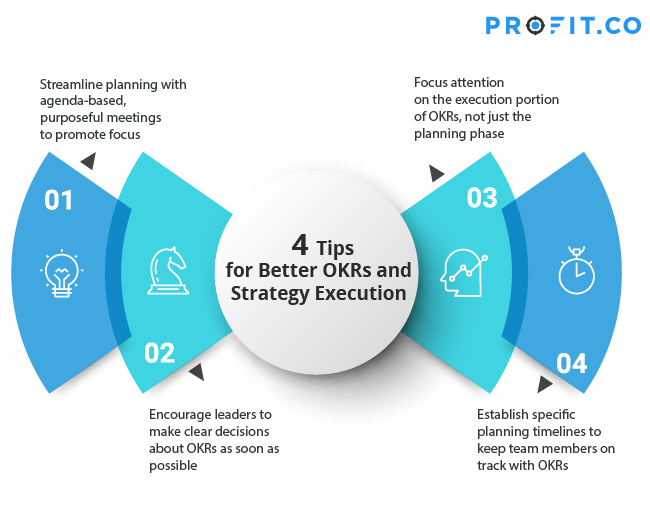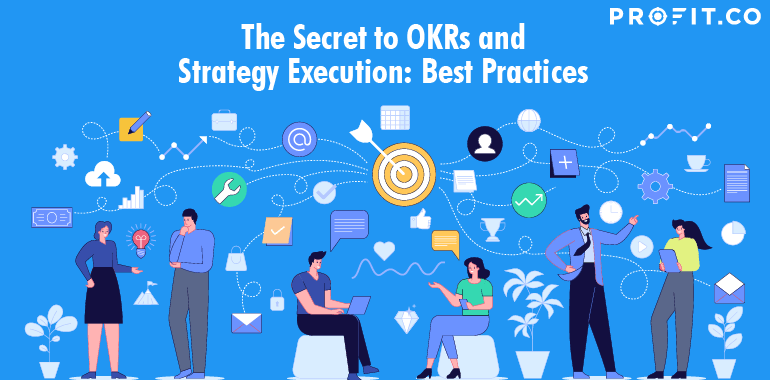Goal-setting, objectives, key results, strategy; all these words fly around the business world today, and are probably mentioned in every business meeting you have. But OKRS and strategy are more than just buzzwords, and strategy execution is easier said than done. Luckily, many businesses use the OKR framework to effectively bridge the gap between their strategy and execution.
So, how do businesses create an OKR framework that delivers results?
First, let’s answer the burning question that someone new to the world of strategy-execution might be asking: What are OKRs?
Objectives and key results (OKRs) is a powerful framework used in the modern workplace because it takes goal-setting to a new level, but are still a simple way to set, track, and measure goals without being overly complicated.
Leaders have to act more quickly today. The pressure comes much faster.
OKRs provide a clear direction for team members to follow. For example, the former CEO of Intel, Andy Grove, explained that OKRs answer: where (the destination/goal) and how (what pace and steps do I need to take to get there).
Organizations often think of Key Performance Indicators (KPIs), but KPIs are different for goal setting. Yes, they serve the purpose of tracking the operations, but KPIs focus more on measurement. On the other hand, OKRs concentrate on the action needed to execute the strategy. Of course, part of the system includes tracking the OKRs throughout the year. The question remains though, what is the secret to OKRS and strategy execution? Let’s dive into best practices.
OKR and Strategy Execution
There are specific methods to managing OKR and strategy. However, there is a fine line between planning and over-planning. Many companies become wrapped up in the strategy and then don’t pay enough attention to the part of the journey that matters most: execution.
Unfortunately, this mentality is contrary to what makes OKRs so effective. Because OKRs focus on action and getting where you want to go, organizations fail to execute correctly.
4 Tips for Better OKRs and Strategy Execution
To ensure your business has a practical strategy implementation framework, keep these things in mind:
- Streamline planning with agenda-based, purposeful meetings to promote focus
- Encourage leaders to make clear decisions about OKRs as soon as possible
- Focus attention on the execution portion of OKRs, not just the planning phase
- Establish specific planning timelines to keep team members on track with OKRs

Proper OKR and strategy implementation may look like a two-week review of the previous quarter, then one week to finalize the OKRs. To help with proper management of OKRs and strategy execution, you can use an OKR management system. For an agile and intuitive software that helps you achieve more, more efficiently, you can try Profit.co completely free today! OKR software includes an OKR tracking page, routine check-ins, fully transparent status updates, and simple adjustments to OKRs throughout the quarter as needed to get the best strategy execution possible.
When organizations think about the execution early, the strategy in developing the OKRs becomes a smooth, repeatable process year after year.
Finding the Balance between Strategy and Execution
The OKR process is becoming more popular for managing companies because it simplifies yet adds meaningful layers to an organization’s management strategy when paired with well-planned execution. As a result, businesses can succeed by creating a clear plan, including setting priorities, learning how to write good OKRs, and making an action plan for each OKR.
Strategy
You can have a magnificent strategy outlined in great detail, but if the employees do not understand the business objectives, they cannot help it move forward. OKRs and aligning people to your strategy are necessary for proper execution. The OKR framework helps the business define, plan, and execute their strategy. From the bottom up, everyone in the organization has a clear picture of the business objectives and achieves those results.
Execution
After the planning, business alignments, and strategy are all defined, organizations still need to execute. Many businesses struggle with strategy execution– and for good reason. Strategy execution might not be adequately planned, or may have the time or resources to be executed effectively. The execution puts the strategy into action.
Another reason may lie in improper communication. Leaders and managers also need to think about OKRs and communicating strategy. After all, if only the leaders understand the strategy and expected key outcomes, the employees cannot align with the strategy and execution. In addition, giving people these crucial details eliminates bureaucracy and can help employees take accountability for their targets. Finally, a communication strategy offers transparency and gets the team members’ buy-in for the business OKRs.
Progress Tracking
If businesses don’t track their progress, they can go months or even the entire year before realizing they need to make adjustments and realign. But how often do OKRs need to be assessed? Some big companies like Google use OKRs on a quarterly time frame. Each business needs to determine what’s the most efficient and best use of progress tracking. The OKR and strategy execution needs to be continuously aligned, measured, and evaluated.
For businesses to stay on top of their OKRs, the company needs each team to monitor the progress. Individuals can connect weekly or bi-weekly with their leader to provide status updates. During these updates, the leader determines how things are progressing towards the end goals. For example, they may need adjustments in the employee’s work or suggest modifications to the OKR to their respective leaders.
Since OKRs are about achieving specific goals, the planning outlines the strategy to execute with perfection. The objectives are what you want to achieve, whereas key results are the outcomes that you must fulfill in order to know your objective is successful. This analysis needs to ensure teams are moving forward without causing unbalanced progress in OKRs execution across the company.
Executing Strategy to Perfection
Modern businesses today are moving from the strict KPI model and incorporating the OKR framework into their business planning strategies. When organizations operate with transparency and an OKR communication strategy, employees are empowered and enjoy autonomy.
A streamlined OKR process offers businesses a framework designed for success. Then, in the planning stage, with structured meetings and decisive leaders ready to select OKRs that make the most sense for the business, the OKRs and strategy execution is implemented. Successful execution of the OKRs includes the leaders communicating the strategy openly and aligning people to the strategy.
When organizations follow these best practices, whether big or small, they can successfully lead their business to achieve nearly anything.
Want to find out more about how an OKR management software like Profit.co can help you better execute your OKR strategy? Book a free demo today with the OKR experts at Profit.co!
Ready to start your OKR Journey for FREE?

